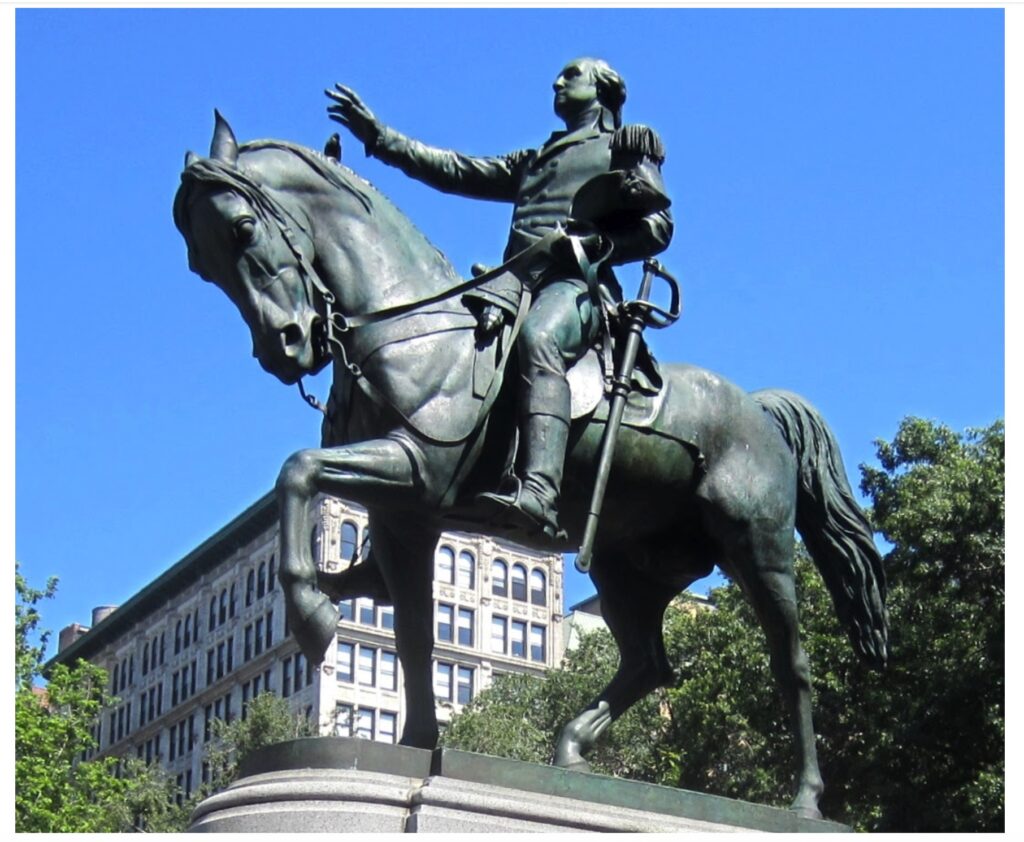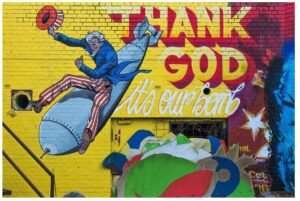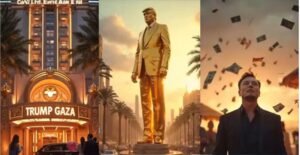Patricia N. Saffran
Independence Day celebrants in New York City on July 4, 1856, were thrilled with the unveiling of the colossal George Washington equestrian statue in Union Square. The New York Herald reported that year on July 5th “When the covering fell, revealing the familiar lineaments of Washington, the universal burst of enthusiasm which arose from troops and citizens in salutation almost drowned the salvos of artillery.” “The statue itself is fourteen feet high. It was cast at Chicopee, Mass, and and weighs 4 tons. It occupied the artist Mr. Henry Kirke Brown for four years. Standing on a granite pedestal, which weighs 100 tons, the statue has an entire elevation of forty feet and is altogether the most prominent object in the square.” (Henry Kirke Brown’s Lincoln statue, dedicated September 16, 1870, faces his Washington statue in Union Square.)
Rev. George W. Bethane spoke at length from the stand, praising the statue, the sculptor, and Washington’s courage and his sacrifices for the nation. About the statue depicted in a Colonial uniform he said, “his sword ever yielded in strength, tempered by mercy, was firmly sheathed, not to be drawn again, for his country’s foes were vanquished and he knew no other.” Bethane concluded with, “Citizens of the UNION, hear me and bear witness, that in the name and by the authority of those who have erected this statue, I give it before God, and our country, to the People of the United States . . . And you people of New York, individually and collectively, and not by any degradation of the trust, but as a democracy, shall be its guardians. GOD SAVE THE REPUBLIC!”
As Rev. Bethane pointed out, New Yorkers were supposed to safeguard Brown’s magnificent George Washington statue for posterity. Instead, the current New York City Council, without any mandate from the general public, is possibly putting this statue, as well as the Federal Hall Washington by John Quincy Adams Ward, 1883, and those of Columbus, Peter Stuyvesant, and many others on the chopping block. It seems that the Cultural Affairs Committee (CAC) of the New York City Council is pushing legislation requiring the Public Design Commission to create a plan to remove art, “that depicts a person who owned enslaved persons or directly benefited economically from slavery, or who participated in systemic crimes against indigenous peoples or other crimes against humanity.” The proposed bill goes further. If the Public Design Commission (PDC) votes (amongst themselves with advisors, public excluded) that an offending work of art of should still stand, then it will receive an “explanatory plaque” with the CAC’s narrow minded version of history.
The problem with the City Council committee’s proposed dictate is that it only represents an opinion formed through modern day sound bites of a small segment of the population, namely certain activists. The Council members of the CAC seem to not be aware of that over 51% general public in the US doesn’t want statues removed. The CAC is also unaware that removing statues of historic figures including Confederates, who may have owned slaves, results in huge spikes in violent crimes, such as happened in New Orleans, Baltimore, Richmond, Charlottesville, Memphis and elsewhere.
When questioned recently if the PDC was aware of the US public not wanting their Confederate and historic statues removed, the crime spikes when it does happen, and the lack of cultural relativism in the CAC’s proposals, Commissioner Liz Garcia and PDA Chair Sreoshy Banerjea refused to answer and merely sent this statement – “PDC is committed to supporting the city’s efforts to reckon with its complicated history and the country’s legacy of racism, prejudice, and inequality. PDC considers a multitude of diverse perspectives to determine which artwork should live on city-owned spaces. While much of our work focuses on reviewing artwork that reflects our diverse city, PDC also weighs in on the recontextualization and removal of artwork, a process that is initiated by city agencies.”
City Council member Joann Ariola from Queens reacted negatively to the proposed statue removal legislation, telling the NY Post September 18, “The Founding Fathers and the others who worked so hard to establish this great country should be celebrated, and not eliminated from memory.” City Council member Republican minority leader Joseph Borelli, from Staten Island, said, “How original. The Council is for a statue-banning committee every year of so, second only to our annual ‘cars are bad’ hearing.” Others have criticized the CAC’s proposals because the City has no funds for statue removals and plaques, as the budget is already deeply in the red.

The PDC may possibly recommend removing the statue of Peter Stuyvesant at Stuyvesant Square, who was Director General of New Netherland, and slave owner in the 17th century. They should instead, under the banner of equity and diversity, protect this statue. The sculptor was Gertrude Vanderbilt Whitney. In 1936 she was given the commission from the Netherland-America Foundation. One item that was debated at the time was which leg of the “testy” Stuyvesant was the peg leg. It was determined that his right leg was the peg leg. Whitney was accurate in her portrayal, as all can see today.
She accepted no fee for the sculpture. At the time, it was difficult for Whitney to be acknowledged as a serious artist because she was a woman and one from a prominent family who married into another. If the Design Commissioners, who are all women, are at all interested in women’s issues, they should be sympathetic to Whitney’s achievements and leave the Stuyvesant sculpture off the list of artwork to be eliminated. Removing the Stuyvesant statue would also destroy the history of the square. The Stuyvesant statue was commissioned, according to the Netherlands-American Foundation, and reported in the New York Herald May 12, 1936, “By placing an effigy of ‘Peter the Testy’ in a prominent place, it is hoped to preserve the identity of this bit of Old New York from modern encroachment, and to continue its association with the Governor, part of whose farm it was. Peter Stuyvesant died there at the age of eighty.”
As to the fate of New York’s artwork more generally, who is to say that what some activists think today is more important than what people thought in 1856, when the Washington statue was dedicated? The public at the statue’s dedication were grateful and respectful for Washington helping establish the republic. “Today, we are seeing the exact opposite, that is, attitudes of confrontation, disrespect, and destruction, with the perpetrators deliberately insulting those who do not agree with them,” explained Brigadier General, Ret., Parker Hills, author of Art of Commemoration concerning monuments at Vicksburg National Military Park. Hills described, “The perpetrators then go out of their way to insult those who disagree by questioning their values and by destroying anything that represents those values. Frankly, it is a culture of hate, and it is being portrayed as just the opposite. Wolves in sheep’s clothing, indeed. The remarkable thing is that these people are insulting not only us, but the people of the past. Once again, how can our forebears be so wrong, and these people be so right?”
In attempting to eliminate the statues of Washington, Stuyvesant, Jefferson and other notables, the CAC is too narrowly focused on a singular aspect of history, namely slavery, which was the norm at the period. The CAC is deliberately ignoring their many accomplishments. As to Jefferson, the City Council, which wouldn’t exist without the Founding Fathers, already moved City Hall’s plaster original of Pierre-Jean David d’Angers’ Jefferson, 1834, in 2021 to the New York Historical Society. In addition, the process the CAC is using to condemn statues mainly in committee is undemocratic. This is the same process that the City used to eliminate the American Museum of Natural History’s TR statue, without justification, bypassing the public.
Please follow and like us:




Check this out at 30 seconds. There is no way (this is from 2016), that Biden is the same one we have today..no way, no how!
Btw, this is the vid Trump’s lawyers showed in court.
https://twitter.com/i/status/1718125268236460235
This is about only one vet on J6…but there are many more.
I WANT THOSE RESPONSIBLE (PELOSI AT THE TOP) TO HANG OR AT LEAST GO TO PRISON FOR WHAT THEY HAVE DONE TO THIS MAN AND HIS FAMILY….AND SO MANY OTHERS. THIS IS TOTALLY UNACCEPTABLE. MIKE JOHNSON…DO SOMETHING NOW!~
https://ussanews.com/2023/10/27/corruption-j6-vet-political-prisoners-kids-are-homeless-due-to-fathers-torture-in-33-month-detention/
We all know the FBI AND the Biden family are corrupt beyond words…but this is proof and more than stunning:
https://twitter.com/i/status/1717347629804249449
Watters: ‘The FBI is blackmailing Biden!’ They think they are above the law and do as they please. The FBI has had 40 informants inside the Biden family for years.
A remarkable poem….hope it posts in total…if not, I’ll break it up:
‘The Reincarnations of Donald J. Trump’: A Poem by Evan Mantyk
The Society October 24, 2023 Beauty, Culture, Epic, Poetry 5 Comments
.
The Reincarnations of Donald J. Trump
after Andrew Benson Brown’s Legends of Liberty
.
I. 218 B.C.
Above the mellow grass, cliff faces soar
Like walls to house a huge primeval god.
The pass into the valley is his door
Through which a hundred thousand soldiers plod.
Their war horns echo, ominous to ears
Of villagers who stand as still as stone;
At once they rush around and shout their fears
Until they are resigned that they’re now owned
By these invaders swarming through the Alps
(In times of utter panic, full submission helps).
“What are those things?” they ask in disbelief
To see such massive creatures lumber in;
It brings them fascination mixed with grief
To see the tube snout, flap-ears, and strange grin
That have been brought from Africa to strike
At Rome’s Republic—crossing first at Spain
Then trudging on a thousand-mile hike
To clutch their foe and rain down epic pain.
These awesome elephants with mounted archers,
However, weren’t most prominent among the marchers.
One stood out as the helmsmen steering all:
Great Hannibal of Carthage, lean and sharp—
A natural commander quick to call
Out orders but not needlessly to carp.
His ready eyes pierce many hundred miles
To Rome, his looming goal and fated doom.
His armies throng in morning light; he smiles
To see the edelweiss are in full bloom.
Some villagers in deference approach.
He says, “Apologies, my friends, we must encroach.”
.
II. A.D. 1796
Though pale-faced locals do not smile back,
Their mayor bows and offers up his sword;
His glances look for signs of an attack
But do not find them on this decked-out lord.
He sees instead the face of confidence
With flag and uniform: red, white, and blue.
Serenely his new liege’s words commence:
“I am a Marshal of the French and you
By now must know the name Napoleon.
He sends me here to find out just which side you’re on.
“He gives to you your freedom from the past
Corruption and injustices you’ve known.
He told my men and me, don’t be a pest
To you, respect your land and all you own;
So if we plunder you, we would face death.
This message shall be brought to all of Europe,
Enlightening the world to our last breath.
Your wealth and homes we will protect, not use up.”
The locals chatter, thoroughly amazed,
And eyes of younger ones look up tear-filled and glazed.
The vast Republican army rests there well.
Young men come close, inquire about enlisting;
And many, one day, will to join the swell
That forms across the continent, persisting
To elevate an Emperor of all…
That is until the wave sinks to oblivion,
The waters never rising from their fall—
The Waterloo that wrecks Napoleon.
For now, though, feet march on in harmony
To join another army soon in Tuscany.
.
III. August, 1943
At last, the marching stops. Then infantry
And lines of tanks stream in past ghastly homes
Eviscerated by artillery.
Through empty window holes a spirit roams,
Soon banished by the joyfulness that comes
On soldiers’ faces flush with victory
And glad to meet their allies, British chums,
Upon a dusty city street in Sicily.
There pointing where to go from on his tank
Is General George Patton sporting a three-star rank.
Reporters, soldiers, townsfolk gather round,
Anticipating his remarks; and he,
For his part, plans to perfectly astound
Them with accounts of just how gallantly
The U.S. Army has performed, and how
It reached the city sooner than the Brits
Did. But, awaiting someone, he for now
Chats with the press who’ve come. His sharp eye flits
From badge to badge and notices a Russian
Reporter, tearing Patton from his glib discussion.
The Russians, allies now against the Germans,
Bring with them power from the East
But also bring their godless party sermons
That are no better than the Nazis’ beast.
Within his mind’s eye, Patton sees what looms:
A force bent on destroying human nature
That fills one hundred million tear-stained tombs;
A century of stinking lies that torture.
He shakes it off, returning to the present,
Addressing everyone with manner rough but pleasant:
.
IV. January 6, 2021
“The fake news media suppress the news.
They have their own opinion, I have mine.
We used to have a fight, express our views;
That’s how it always worked and that worked fine.
But now they’re more like communists, who won’t
Report that hundreds of thousands gather here;
Who all know there is something wrong and want
Elections that are free of fraud and clear
Of any hint that ballots were abused,
Were harvested, were forged—egregiously misused.”
Concluding his remarks, Don Trump calls for
A peaceful fight to win the people’s trust
By marching to the legislature’s door
And simply asking for what’s fair and just;
But little does he know that traps are laid:
The Speaker of the House, the FBI,
and certain generals have not yet played
Their hands. They watch with eager eagle eye
In hopes that riots will destroy this movement
That sees a land made “great again” as an improvement.
The driver tells him that it is not safe
If they continue to the Capitol building
As planned. The shackles of reality chafe
As Trump now sees he’s trapped—the rage ungilding
For just a moment, then it’s gone; he knows
He is not in this for himself, nor for
A single party. But he hears his foes
Are laughing at his useless marching corps.
The shadows cast by birds of prey above
Fly ravenously round the nation’s turtle dove.
.
V.
“Who is that?” he asks while looking out,
Through trees, at evening’s blinding final ray—
A silhouetted figure rides a route
Just out of view, flanked by a vast array
Of followers. A man of flesh or light?
The one who lived in legends come at last?
Who lifetime after lifetime slips from sight
Into the misty future from the past?
Who is it gathering his forces there,
Existing less in form than in the troubled air?
It is the one this soul has always followed,
Who now retakes the high ground and who holds
Within his one hand all that’s holy, hallowed,
And heavenly, emitting beams of gold;
Who holds within the other hand a scepter
Unleashing crushing force from warrior angels
Splitting to bloody shreds the Marxist specter
While flying from ten thousand deadly angles.
He has returned, the Emperor of Light,
Who’s come to save us all, including this same knight.
.
.
A monumental rant and FROM A DEMOCRAT!
https://twitter.com/i/status/1715744540877815993
The problem is that no one in history is a saint–even the Catholic Church acknowledges that its saints weren’t perfect. Are we to get rid of MLK statues because he was a philanderer and a plagiarist? Are we to get rid of ones of Ben Franklin (slaveowner and philanderer) or Abraham Lincoln (corporate shill who arrested hundreds of journalists and state legislators and even a Supreme Court Justice at the beginning of the Civil War) or Mahatma Ghandi (domestic violence)? And what about all those enlightened men in the 1800’s and early 1900’s who lived with wives who had no right to vote and were denied basic freedoms? And what about all the eugenicists among the early feminists, like Margaret Sanger? And what about our current generation, which eats animal meats and promotes toxic COVID vaccines to depopulate–how will future generations our leaders? Pull all the statues down, except for those of Lenin and Mao! (No kidding, in San Antonio, TX, a statue of Columbus in front of an Italian Society plaza named after him was recently pulled down while statues of Lenin and Mao were placed nearby!)
Could not agree more, William……and what about those confederate statues taken down in Charlottesville? Why? The answer to that is because they could. But why did they stop at that? After all, Jefferson was not only a slave owner, but also had at least one child from a slave. Why not demolish Monticello or the UVA rotunda, eh?
The answer to that is because they knew they COULD NOT. They know how far to go. They follow a script.
Maybe you could clarify this sentence: “And what about our current generation, which eats animal meats and promotes toxic COVID vaccines to depopulate–how will future generations our leaders?”
As you stated…no leader is perfect. Thank God. They’re human. Trump has his faults, but I never doubt his devotion to the USA and his sincerity.
As far as Biden is concerned? He’s a walking doubt. A walking mistake. An accident waiting to happen. An idiot and crook by default.